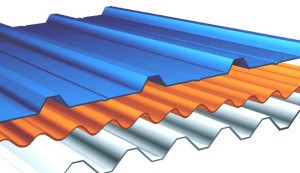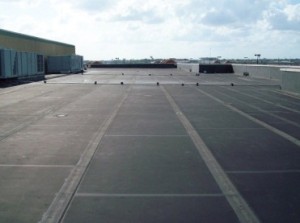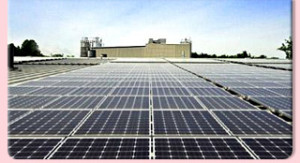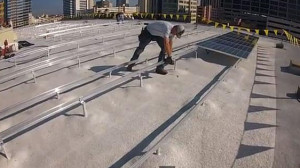HAVE YOU HEARD OF THESE ALTERNATIVE ROOFING MATERIALS?
Are you considering replacing the roof on your building? Are you constructing a new building and trying to decide what roofing material you should use? We’ve all heard of metal panels being installed on commercial roofs, but alternative systems don’t get the publicity they often deserve. Don’t focus only on the traditional roofing systems and the roofing materials you are familiar with; branch out and research all roofing materials available to you, even the alternative roofing materials we will examine here. Once you have examined all your options, then you can make the best, most informed decision as to which roofing material is optimal in your situation.
Traditional Roofing Materials
These are the roofing materials you will probably be familiar with before reading on. If you are considering materials to put on your roof, you have most likely already evaluated these as potential solutions for your roof. The most common traditional roofing materials are metal, built-up, and single-ply roofs. Each of these has been around for quite some time, and they have each become trusted and well-known in the construction world thanks to their long track record.

Metal Roofs
Metal roofs have been an extremely common flat roofing material for many years. They are often found on large flat roofs, and you may also see them on steeper sloped roofs with regularity. Imagine an old barn roof that you have seen, it probably had a metal roof on it.
One of the most significant advantages of metal roofs is the strength they provide. Once installed, they generally withstand the elements and resist wind uplift very well. They can also handle extensive foot traffic without trouble. The strength of a particular metal roof can vary depending on which type of metal roof is on the building.
Among the weaknesses of metal roofs are the tendency to rust over time, the seams on the roof surface, and the lack of insulating capabilities exhibited by the material. All three of these problems are quite evident and require little explaining. Rust and failure at the seams often require repair work on a metal roof that is not required on other roofing systems.
Rust is an obvious problem as it weakens the roof surface, can lead to leaks, and in general decreases the structural integrity of the roof. The seams are another potential cause of roof failure, oftentimes allowing uninvited water into the building. Finally, the lack of insulating capabilities leads to higher costs heating and cooling your building. They seams contribute the building getting hotter in the summer and colder in the winter.
Built-Up Roofs
More commonly known as BUR, built-up roofs have been around even longer than metal roofs. They typically consist of alternating layers, one of which is usually tar. On top, it is common to see hot tar laid down and gravel laid in the tar. BURs that are topped with gravel can be very aesthetically pleasing and offer a more useful roof surface than most other flat roofs.
One of the greatest advantages of installing BUR is the insulation value it provides. Thanks to its many layers, as well as the quality of each layer, the system is a great insulator and can save building owners money on their heating and cooling costs. Another advantage the system offers is its strength. BURs are very strong, and can support foot traffic and large roof fixtures without showing any signs of stress.
Weaknesses of the BUR system are its weight and installation concerns. Along with great insulation, many layers mean the roof becomes very heavy and often requires reinforcements to support the roof during installation. If the original building did not utilize a BUR, installing one over top of the existing roof can be an extremely difficult task that requires bolstering the support system of the roof.
Along with the difficulty of reinforcing the building, the installation process is generally thought to be a dangerous one and therefore, the building is recommended to be empty while the work is done. This means all work stops while the roof is installed, which means you are spending a lot of money putting in the roof, and you’re not making any money with your building.

Single-Ply Roofs
Single-ply roofs have also been around for a pretty long time, and they have become a trusted option to put on commercial roofs. Most people elect to install single-ply because most systems in the family are very inexpensive. They are typically easy to install and don’t require specialized equipment which keeps the cost low.
There are many different types of single-ply roofs, among them are modified bitumen, PVC, TPO, and EPDM. There are many other types in the single-ply family, but these are the most common. Each of them is considered to be a good option when it comes to reflectivity, meaning they keep your building cooler in the summer by not absorbing UV rays.
The biggest problem among single-ply systems is undoubtedly the seams in the system. Because they are roll-applied, there are seams on the surface where one roll ends and the next begins. Even when installed correctly, this can lead to roof failure in the form of leaks and poor insulation as holes often develop.
Alternative Roofing Materials
Living Roofs
Probably the most interesting of the alternative roofing materials, living roofs have been in existence for a while but have only recently started to gain popularity in the roofing world. These roofs consist of a roof deck, a protective barrier (often rolls of HDPE), soil, and plants, thus the name “living roof”. The plants can be indigenous to the region around the roof or they can be brought in from other regions, so long as the climates are comparable.
The obvious advantage of this system is the impact on the local ecosystem; any time foliage is planted it helps the environment, and living roofs are no different. One effect that the plants have that most people don’t know about is the mitigation of the urban heat island effect. Basically, this is when a large number of buildings reflect the sunlight back into the atmosphere and heat up the area over the buildings. Urban heat islands have been shown to impact temperatures and weather patterns up to several miles away from the metropolis. No single building can eliminate the effect, but each building that installs a living roof can help.
The greatest problem with living roofs is the difficulty in maintaining them. Plants must be watered and maintained or trimmed, soil must be changed out, and dead plants must be replaced. This can lead to a lot more work, time, money, and headache than a traditional roofing system. Another downfall of the system is that any roofing repairs that need to be made require an extra step of removing the plant life and the soil beneath it.

Solar Roofs
This is not so much a roofing system as much as it is a feature on top of the roofing system. Solar panels can be installed over any roofing system, and then we all know that they harness the sun’s energy and convert it into usable energy for the building. Solar panels have been used sparsely until now, but as the technology improves it becomes both more affordable and more effective.
Solar panels are great for one reason: they provide energy for the building that is free after the initial costs have been recouped. That can many times be very far down the road because the cost of material and the installation is so expensive. Another potential advantage could be the aesthetic value of the panels as many people view them as nice roof features. There may also be social pride that the building owner feels if they are trying to support the environment, rather than merely save money.
The weaknesses of the system include high installation costs and high maintenance costs. Both of these costs are high because the material is still being put through development and there aren’t many suppliers or installers that work with solar panels out there.
Sprayed Polyurethane Foam Roofs
SPF roofs have become significantly more popular in the last decade thanks to the best performance on the market. SPF roofs have been in use since the 60’s, but they are still largely unheard despite their strong track record and recent surge in the market.
There are many SPF advantages that we won’t cover here. Some of the more important advantages are the R-value of the material, which is the highest on the market and means it is the best roofing system available in terms of insulation. SPF is almost one of the best materials when it comes to resisting the elements and wind uplift. The system is seamless and fully adhered to the roof deck, so there are no weak points that allow the elements in.
The system is more expensive at installation, which is often perceived as a weak point, but the energy savings alone can recoup the additional cost of installation in as little as 5 years.

Solar and SPF Roofs
Solar panels and SPF roofs can work together to save building owners significant amounts of money if installed together on a roof. While SPF works to keep the climate inside the building at a desired level, the solar panels absorb the sun’s rays and convert light into energy which can then be used to heat and cool the building. If the solar panels are powerful enough, SPF and solar panels can work together to achieve net zero electric bills with regards to heating and cooling.
This is a combination of roofing materials that is not often considered, which is why it is on the alternative roofing materials list we are covering. However, as solar panel technology improves and SPF becomes a more popular flat roofing option, look to see more building owners utilizing both systems on their roofs.
Restoration Coatings
Restoration coatings are a roofing material that cannot exist by itself. They are only applied to a flat roofing system that already has a roofing material in place. They are generally spray-applied, and therefore have to have a surface to be sprayed onto for the system to work (they can also be roll-applied but that is more rare).
Restoration coatings serve to extend the life of the existing roof. Rather than remove and replace the existing roofing system that may be deteriorating or failing, restoration coatings can oftentimes be applied to help extend the life of the flat roofing system. Because the coatings protect the existing roof from the elements, they make the roofing system underneath last longer.
At the end of the life of a restoration coating, if the coating chosen was silicone, another layer can be spray-applied again and the life of the roof can be extended 10-15 more years with a minimal investment. Restoration coatings may not be a stand-alone system, but the way that they improve the roofing systems they are applied to and the amount of time they usually last make them a great alternative flat roofing material.
SPF + Silicone
When SPF roofs are installed, they require a top layer other than SPF be installed to protect the foam from UV rays emitted by the sun. These rays break down the foam and cause it to fail extremely rapidly if not protected. However, once a protective layer is installed, the foam can last 10-20 years without replacing the protective coating.
The protective layer can take many different forms, often it is an acrylic coating, a silicone coating, and even gravel can be used to protect the foam. While each material has its own strengths and weaknesses and can be used in many different situations, silicone is the best overall option to be used with SPF roofs. This is because silicone has such highly reflective properties; it helps to complement the SPF’s insulation abilities. The reflectivity and insulation abilities of the two materials work together to create one of the most effective insulating roofs on the market.
Conclusion
There are a multitude of flat roofing materials and systems in the roofing industry. Each one has its own strengths and weaknesses and performs a certain way under certain conditions. It can be difficult to know which roofing system, alternative or traditional, will be best for your building, but one way to ease your mind when choosing a system is to make yourself aware of the roofing systems available. Hopefully, if you are reading this conclusion you read the rest of this post and have learned about the materials available to you and your building.